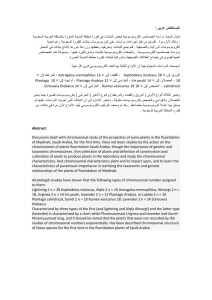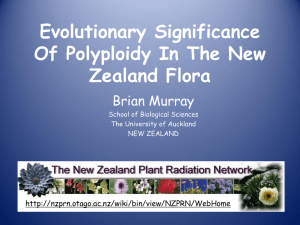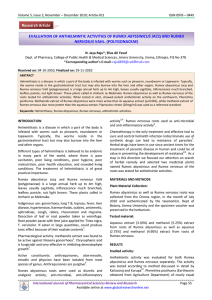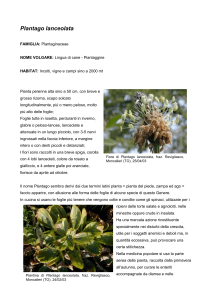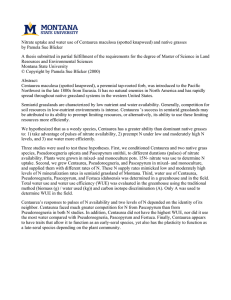jbi12353-sup-0001-AppendixS1-S3
advertisement
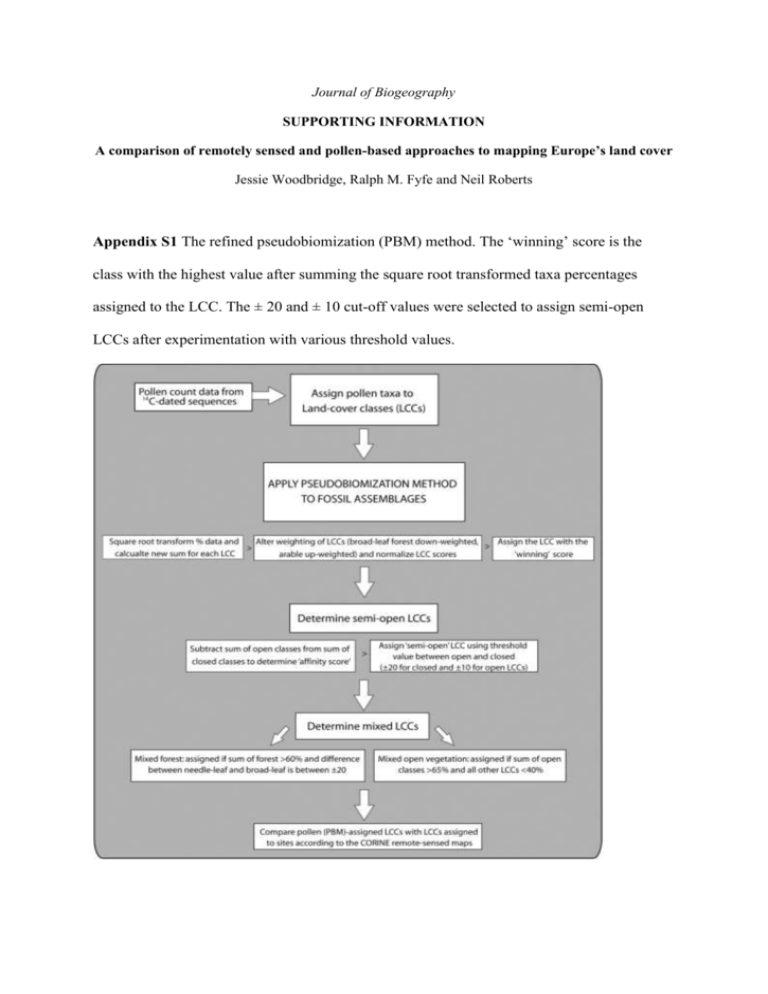
Journal of Biogeography SUPPORTING INFORMATION A comparison of remotely sensed and pollen-based approaches to mapping Europe’s land cover Jessie Woodbridge, Ralph M. Fyfe and Neil Roberts Appendix S1 The refined pseudobiomization (PBM) method. The ‘winning’ score is the class with the highest value after summing the square root transformed taxa percentages assigned to the LCC. The ± 20 and ± 10 cut-off values were selected to assign semi-open LCCs after experimentation with various threshold values. Appendix S2 Pseudobiomization (PBM) pollen-assigned land-cover classes (LCCs) with amalgamated remotely sensed CORINE classes and PBM-assigned pollen taxa. Taxa were grouped at genus/species levels to suit the land-cover classification system. LCC Amalgamated CORINE classes Coniferous forest Pollen taxa assigned for PBM 1a Needle-leaf forest Abies, Larix, Picea, Pinus, Taxus 1b Broad-leaf forest Broad-leaf forest Olive groves Vineyards Fruit trees and berry plantations Acer, Aesculus, Alnus, Betula, Buxus, Carpinus, Castanea, Celtis, Corylus, Crataegus, Daphne, Fagus, Fraxinus, Hedera, Ilex, Juglans, Myrica, Myrtaceae, Olea europaea, Parrotia, Platanus, Populus, Prunus, deciduous Quercus, Rhamnaceae, Salix, Sambucus nigra, Sorbus, Tilia, Ulmus, Vitis 1c Mixed forest (dominated by a mix of needle-leaf and broadleaf forest) Transitional woodland–shrub Mixed forest Defined by thresholds between different forest types 2 Semi-open vegetation (mixed land cover including both forest and open vegetation) Defined by thresholds between other classes Defined by thresholds between other classes 3a Heath/scrubland Moors and heathland Peatbogs Sclerophyllous vegetation Aellenia, Argania spinosa, Astragalus, Calluna, Carex, Casuarina, Ceratonia, Casuarina, Cistaceae, Cytisus/Genista, Echium, Empetrum, Ephedra, Erica, Fontanesia/Phillyrea, Juniperus, Ledum palustre, Ligustrum, Olea type, Pistacia, Polygonum amphibium, evergreen Quercus, Syringa, Tamarix 3b Pastures/natural grassland Pastures Natural grasslands Anemone, Apiaceae, Asperula, Bunium, Bupleurum, Caltha, Campanulaceae, Centaurea jacea, Centaurea nigra, Centaurea scabiosa, Comarum palustre, Compositae (Asteraceae), Dipsacaceae, Epilobium, Filipendula, Galium, Gentiana, Liguliflorae (Asteraceae), Papaveraceae, Plantago alpina, Plantago coronopus, Plantago lanceolata, Plantago tenuiflora, Pleurospermum austriacum, Poaceae, Potentilla, Ranunculaceae, Rumex acetosa/acetosella, Ruppia, Sanguisorba, Saxifraga, Stachys, Succisa, Thalictrum, Trifolium, Trollius, Urticaceae, Valerianaceae, Veronica, Viciaceae 3c Arable/disturbed land Non-irrigated arable land Permanently irrigated land Rice fields Annual crops associated with permanent crops Complex cultivation patterns Allium, Arctium, Artemisia, Asparagaceae, Asteraceae type, Avena, Brassicaceae, Calligonum, Caryophyllaceae, Centaurea collina, Centaurea cyanus, Centaurea depressa, Centaurea Montana, Centaurea rhenana, Centaurea solstitialis, Centaurea type, Centaurium maritimum, Cerealia, Chenopodiaceae, Fagopyrum, Hordeum, Lamiaceae, Leguminosae, Linaceae, Noaea, Phaseolus, Plantago albicans, Plantago atrata, Plantago afra, Plantago cylindrica, Plantago lusitanica, Plantago major, Plantago maritima, Plantago media, Plantago montana, Plantago ovata, Plantago psyllium, Plantago type, Polygonum aviculare, Polygonum bistorta, Polygonum cognatum, Polygonum persicaria, Prosopis, Punica, Rumex alpestris, Rumex alpinus, Rumex aquaticus, Rumex conglomeratus, Rumex crispus, Rumex hydrolapathum, Rumex longifolius, Rumex obtusifolius, Rumex sanguineus, Rumex type, Secale, Silenaceae, Solanaceae, Spinacia, Triticum, Zea 3d Mixed open vegetation (dominated by a combination of heath/scrubland, pastures/natural grassland and arable land) Land principally occupied by agriculture, with significant areas of natural vegetation Agro-forestry areas Defined by thresholds between open classes Defined by thresholds between other classes Appendix S3 Confusion matrix illustrating the total closed forest (sum of needle-leaf, broadleaf and mixed forest), semi-open vegetation and total open (heath/scrubland, pasture/natural grassland and arable land) percentage match between the CORINE and pseudobiomization (PBM) pollen-inferred land-cover classes (LCCs) for 2471 European sites. Pollen → CORINE ↓ Closed Semiopen Open Closed 53.18 39.21 25.88 Semi-open 21.36 22.89 13.42 Open 25.45 37.89 60.70
